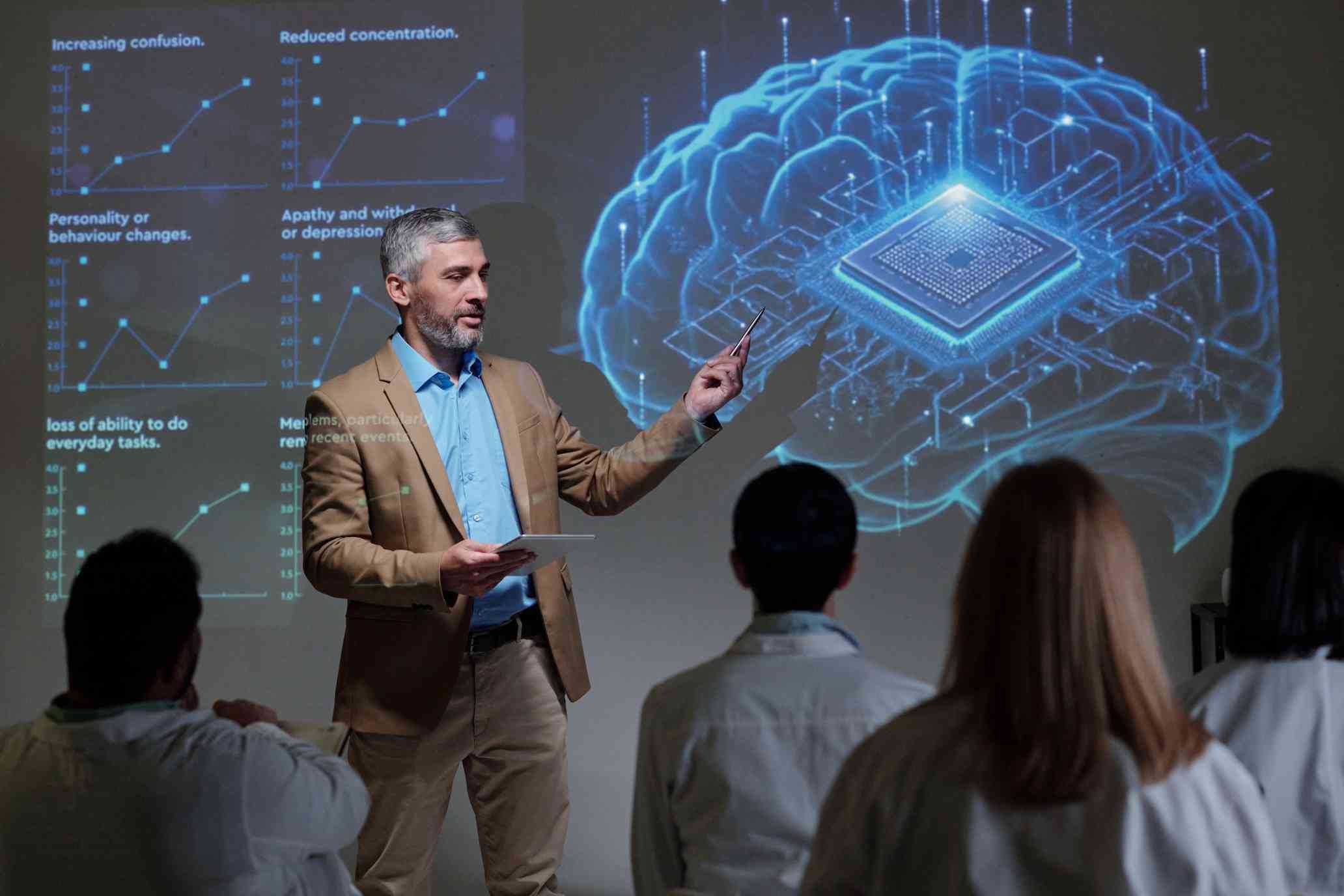What is Machine Learning in AI
Machine learning, or strojno učenje, is a core branch of artificial intelligence. It’s the process that allows machines to learn from data and improve over time without being explicitly programmed. By identifying patterns and making predictions, machine learning powers innovations like personalized recommendations, autonomous vehicles, and advanced medical diagnostics. As AI continues to shape industries worldwide, understanding machine learning is essential for grasping how technology is evolving to solve complex problems.
Understanding Machine Learning
Machine learning is shaping the way we interact with technology every day, even if we might not realize it. It’s at the heart of systems that suggest Netflix shows, recommend Amazon products, and even power AI chatbots. To truly appreciate its role, let’s break it down into simpler terms.
What is Machine Learning?
Machine learning (ML) is a powerful type of artificial intelligence (AI) that enables machines to act without explicit instructions. In simple terms, it’s how computers learn to do tasks by analyzing data and recognizing patterns. Instead of programming rules for every decision, we feed the machine data, and it finds those rules on its own.
Consider how spam filters work in email. Models are trained on massive datasets containing spam and non-spam emails to identify the cues—like suspicious links or phrases—unique to each. This allows the system to block unwanted emails automatically. For a more comprehensive overview, you can check out IBM’s explanation of machine learning.
How Does Machine Learning Work?
The process might sound complex, but it can be boiled down into three main steps:
- Data Collection: Machines need examples to learn. These are the datasets, like sales records, cat photos, or historical trends, that machines use to identify patterns. Without high-quality data, models won’t work effectively.
- Algorithms: Algorithms act as the recipe for learning. Common ones include decision trees, gradient boosting, and neural networks. These mathematical frameworks help machines recognize relationships in the data.
- Model Training and Testing: Once data is fed into the algorithm, the model is “trained” by continuously tweaking itself to improve accuracy. After training, it’s tested with new data to make sure it doesn’t just memorize but generalizes well.
Supercharge your understanding of machine learning models with ease by relating it to a cooking analogy: The data is your ingredients, the algorithm is your recipe, and model training is you perfecting the dish. Machines, however, take this process to a level of efficiency we humans can’t achieve.
If you’d like to explore how machine learning can combat online risks, this article about AI and fraud detection provides fantastic insights.
Types of Machine Learning
Machine learning isn’t “one size fits all.” Different techniques suit different challenges. Let’s simplify the three basic types:
Supervised Learning:
Supervised learning is like a student working with a tutor. Machines are given labeled data (input-output pairs) and tasked with learning the relationship. For example:
- In predicting house prices, the model learns from past data where input (features like size or location) maps to output (house price).
Unsupervised Learning:
Here, there are no “answers” provided upfront. Machines analyze patterns within raw, unlabeled data. It’s like being in a puzzle with no picture: figuring out clusters or segments. For instance:
- Streaming services use it to group users with similar content preferences so recommendations can be personalized.
Reinforcement Learning:
Think of this as learning through trial and error. A machine interacts with its environment to achieve a goal, receiving rewards for successes and penalties for mistakes. A famous example:
- AI systems teaching themselves to play chess through rewards for checkmates and penalties for losses.
Want a deeper dive into types and challenges? The Wikipedia guide on machine learning is a solid resource.
This is just the tip of the iceberg for understanding machine learning. These foundational concepts should help demystify what goes on behind the AI systems we encounter daily.
Applications of Machine Learning in Artificial Intelligence
Machine learning has expanded far beyond academic discussions or theoretical frameworks. It’s the driving force behind many technological advancements that become part of our daily lives. Within the broader field of artificial intelligence (AI), machine learning (ML) serves as the foundation for systems that go from smart assistants to life-saving technologies.
Machine Learning in Daily Life
Machine learning influences and shapes much of what we experience daily, often without us realizing it. It’s incredible how seamless these integrations have become, making once futuristic technologies ubiquitous in our lives.
- Personalized Recommendations: Every time you watch a video on YouTube or shop on Amazon, ML algorithms are working behind the scenes. These systems analyze your behavior and compare it with millions of other users to suggest what you might like next. For detailed insight, check platforms like GeeksforGeeks where these applications are explained further.
- Voice Assistants: Devices such as Alexa, Siri, and Google Assistant utilize machine learning to understand natural language. They learn from your queries to deliver more accurate results over time while also integrating new functionalities like reminders or smart-home controls.
- Fraud Detection: Financial institutions rely on machine learning algorithms to identify anomalies in transaction data. These tools flag unusual activity, helping to mitigate risks of fraud. If you’re curious about the intersection of ML and fraud detection, read this detailed explanation on how AI transforms fraud protection.
Machine learning ensures that the systems we interact with adapt and innovate constantly, balancing convenience with cutting-edge precision.
Advanced AI Applications
Machine learning doesn’t just stop at everyday conveniences—it plays a significant role in the development of more intricate AI systems. These systems tackle complex problems in diverse industries, moving us closer to futuristic visions of AI.
- Robotics: Advanced machine learning algorithms allow robots to not only perform repetitive tasks but also adapt to new situations. Autonomous robots, for example, use reinforcement learning to navigate and make real-time decisions in dynamic environments.
- Image Recognition: Have you noticed how your smartphone automatically organizes your images based on faces or objects? Image recognition systems powered by deep learning models make this possible. These same principles are applied in medical image analysis for disease diagnosis, revolutionizing healthcare.
- Predictive Analytics: Businesses increasingly rely on ML to forecast trends and optimize decision-making. Predictive analytics uses historical data to anticipate future demand, inventory levels, or even breakdowns in machinery. Learn more on this by diving into Google Cloud’s AI applications overview.
Machine learning elevates AI systems to handle complex challenges with controlled efficiency. The possibilities, from enhancing medical research to creating precise forecasting tools, continue to grow with innovation.
With these applications, it’s clear that machine learning has embedded itself deeply into our technologies, whether for daily conveniences or groundbreaking advancements in AI.
Challenges and Limitations
While machine learning enables remarkable advancements in artificial intelligence, it faces challenges and limitations that can’t be ignored. To implement effective systems and ensure ethical practices, it’s essential to address these.
Data Quality and Bias
Data is the backbone of machine learning, but not all datasets are created equal. When data lacks quality or represents a skewed perspective, it causes significant problems for machine learning models.
- Inconsistent or Incomplete Data: Imagine training a machine learning model to identify plants, but the dataset excludes certain species or features, like size or seasonal changes. The model becomes unreliable, creating incorrect predictions.
- Bias in Dataset Composition: Bias creeps in when datasets disproportionately represent certain groups or scenarios. For instance, facial recognition systems trained on datasets lacking diversity often misclassify faces from underrepresented ethnic groups, leading to discriminatory outputs.
- Data Volume Challenges: Large datasets are a must for high-performing models, but they also demand substantial computational power and storage. Without these resources, your model may underperform or stagnate.
To read more about how poor data affects machine learning, check out the detailed challenges on Medium.
The solution lies in curating and preprocessing data carefully. Balanced, diverse datasets and proper cleaning tools can minimize bias and improve the reliability of machine learning models.
Ethical Considerations
Ethical dilemmas are among the most crucial limitations of machine learning systems in AI. These go beyond technical challenges—they tread into societal impact and human rights.
- Privacy Concerns: Machine learning requires massive datasets, many of which include personally identifiable information (PII). Whether it’s social media habits, browsing behavior, or location data, privacy becomes an immediate risk. For instance, companies mishandling sensitive data can lead to breaches or exploitation.
- Algorithmic Bias: Algorithms mirror the biases found in their training data. For example, hiring tools trained on historical company data may perpetuate discriminatory hiring trends if bias exists in the collected records.
- Accountability Issues: Another concern involves responsibility. When decisions are made by opaque algorithms, determining who—or what—is accountable for negative outcomes becomes blurred.
For an in-depth exploration of these ethical hurdles, the Onix Systems limitations overview is incredibly insightful.
To tackle ethical challenges, it’s essential to implement transparency practices, audit datasets for bias regularly, and strictly regulate the collection and use of personal information. These measures ensure that the broad adoption of machine learning respects user privacy and societal values.
By understanding the challenges machine learning faces in both data and ethical considerations, developers and organizations can focus on building systems that not only perform better but also align with fundamental values.
The Future of Machine Learning
Machine learning is evolving at an extraordinary pace, shaping technologies that impact industries and everyday life. As we advance further into this field, the possibilities seem limitless. But what’s next in the world of machine learning? From breakthroughs in deep learning to the integration of quantum computing, here’s a closer look at the trends and societal shifts that will define the future of this technology.
Emerging Trends
The rapid development and integration of machine learning across industries have sparked exciting trends that promise to push the boundaries of what’s possible. Here are the standout areas shaping the road ahead:
- Deep Learning Advancements: Deep learning models are becoming more sophisticated, allowing machines to perform tasks that were unimaginable just years ago. For instance, the use of neural networks to create hyper-realistic digital images and videos has exploded, signaling an exciting phase in the development of generative AI. Platforms like ChatGPT and DALL·E are just the beginning, with future systems promising even better performance in natural language processing and computer vision. To dive deeper, this 365DataScience article sheds light on how machine learning is transforming AI-driven automation.
- Generative AI Expansion: Generative AI, including tools like mid-journey and advanced language models, is making waves in both creative industries and business sectors. Imagine machines creating art, writing stories, or even composing music. Businesses are also harnessing these tools for personalized marketing campaigns and product innovations. This form of machine learning encourages creativity to merge with automation at scale.
- Integration of Quantum Computing: Quantum computing holds the key to processing massive datasets far beyond the capabilities of current classical systems. With quantum-enhanced algorithms, machine learning models will improve at an unprecedented level. The acceleration in research and efficiency might revolutionize industries like pharmaceuticals, financial modeling, and logistics optimization. To explore more trends, this article from TechTarget offers further insights into how machine learning may be enhanced by quantum innovation.
While we’re only scratching the surface, these trends indicate that the future of machine learning will redefine boundaries—not just for businesses but for society as a whole.
Societal Impact
As machine learning technologies evolve, the influence on society and industries will be profound. But such changes come with both opportunities and challenges, especially as these technologies disrupt conventional norms.
Transforming Industries
Machine learning’s application across industries is rapidly transforming how businesses operate and deliver to their customers:
- Healthcare: Machine learning is enabling earlier detection of diseases and personalized medicine. Algorithms analyze patient data to recommend treatments tailored to individual needs.
- Education: Adaptive learning platforms adjust their methodologies based on the learner’s progress, ensuring personalized education paths for students of varying abilities.
- Transportation: Autonomous vehicles are set to revolutionize logistics and personal transport systems, reducing human error and improving safety.
If you’re interested in the role AI plays in modern problem-solving, check out how AI impacts fraud prevention.
The Impact on Employment
Job displacement is one of the most debated societal effects of machine learning advancements. While some roles requiring repetitive tasks are at risk, new opportunities are emerging in fields like AI safety, data science, and machine learning engineering:
- Automation in Factories: Machines capable of quality control and product assembly will inevitably replace traditional roles while scaling productivity.
- AI in Creative Fields: Fields like graphic design and content creation may see a shift as AI tools dominate basic creative tasks.
- Upskilling Workers: Organizations are encouraging employees to learn data-handling and AI-specific skills to bridge the growing gap in technology-based roles.
Companies must prepare to balance technological progress with ethical employment transitions. Alongside this, ethical dilemmas like bias, privacy, and accountability in AI decision-making will rise, demanding appropriate policies and oversight.
Machine learning is fast becoming the backbone of our modern digital experiences, from how we shop to how industries innovate. The technologies shaping the future aren’t just about new capabilities—they’re also about redefining how society functions and adapts to change.
Conclusion
Machine learning stands as a pivotal component in the evolution of artificial intelligence. Its capability to analyze data, recognize patterns, and make informed predictions has redefined industries—from personalized entertainment to advanced healthcare systems.
As we move forward, the advancements in generative AI, edge computing, and ethical AI practices will drive this field into uncharted territory. The future promises more sustainable machine learning models and transformative applications, especially in critical domains like medicine and robotics.
Implementing machine learning responsibly is the key to unlocking its full potential while addressing ethical and data challenges. For further insights into its impact, explore how AI reshapes fraud detection systems. What applications of machine learning do you think will transform our lives next? Your thoughts matter—let’s discuss!









